INTRODUCTION
My first DVD was a Philips DVD718 that gave me nearly 10 years of good service. It was large and bulky, had the tray balanced bang in the centre, and had just a composite out. But, connected to a CRT, it played standard DVDs quite well. It had a bad habit of rejecting a number of DVDs as well as not understanding things like DiVX. After a lot of searching on the Net, I downloaded a firmware upgrade. After destroying some 6 odd CDs, it happily gulped the firmware, burped with an evil grin, and continued it's old behaviour of spitting out DVDs it did not like. But, for all it's idiosyncrasies, we lived happily together till the poor thing croaked about 3 odd years ago. I took the player to a Philips service centre who welcomed me and the player with large smiles written all over their faces. I was wondering why they were so happy, when they threw a Rs.15,000 and an unknown time estimate at me. Tucking my tail in and the DVD player firmly in my hands, I headed home. Given the fact that I was addicted to movies, what was I going to do next?
I had already started looking for an alternate DVD Player some five years ago, as I knew the Philips was nearing the end of it's life. My bible for DVDs, at least those days, was the DVD Benchmark of Secrets of Home Theater and Hi Fidelity (http://www.hometheaterhifi.com/cgi-...ype=&manufacturer=0&maxprice=0&deInt=0&mpeg=0) . Those days, Panasonic was dominating the Benchmark, and many reviewers were speaking of Panasonic's S97 with hushed tones. Unfortunately, though I trudged through every shop in Sim Lim Square and as many shops as possible in KL, it was just not available in Asia. It seemed to be a model specially made for the US, and I had an aversion to 110 volts.
Back home in India I had a seen a number of Pioneer players being sold and used all over, particular in buses, video rental shops and other places. Though the Benchmark did review some Pioneer players, their reviews were mixed. Some models were hailed as the 'best budget player'. Some were downright kicked out as 'a player I cannot recommend'. I then started surfing around for other reviews and found other sites were consistently happy with Pioneer players. The 696, in particular, was praised as an excellent player for the money.
So, in one of my trips to Singapore, I walked into a shop in Sim Lim Square and picked up a Pioneer DV-585. Connected to a Sharp 29 inch CRT, the player has given me excellent service for the last 4 odd years. A very simple player, the DV-585 had all the features I was looking for - 5.1, Dolby, DTS decoding, co-ax and optical digital out, 6 channel 192 kHz/24-bit D/A Converter, and 108 MHz/12-bit Video Signal D/A Converter. For the roughly Rs.3,500 (100 odd dollars), that I paid for it, I was very happy with it's performance.
About two years ago, I purchased a 32 inch flat TV and was planning for a HT system. So, it was time for a serious upgrade to the DVD Player. The 585 was sent to a bedroom with the Sharp TV where it continues to be used quite effectively. I started looking at Panasonic players again, but could not find one. Last April, I travelled extensively across Europe and thought that was a great opportunity to get a good player. In Amsterdam, I was walking in a street that had a number of electronic shops, and presto, a Panasonic S97 was displayed in all it's glory. I just could not resist and walked into the shop. Though I was ready to pay the 150 odd Euros the shop keeper asked for, he kept saying 'no play', 'no work India' and vague things like that. I just could not understand what he meant. Maybe he was talking about region code or that it had non-English messages. Anyhow hoping to find the same player in another shop, I started walking across a few more shops when I saw a window full of Pioneer players. It was like water to a guy who had just trudged across 100 miles of desert. Literally licking my lips in anticipation, I walked in, paid some 80 odd Euros and picked up a DV-696 without even giving the shopkeeper time to open his mouth. In my hurry I overlooked a few things that would haunt me for the next few months. One; made in Belgium, the player did not have an English manual. This was not too much of an issue as I was able to download the English version. More important, the player refused to play any DVD I threw at it. It was locked for Region 2, and that was it. I took the player to a couple of Pioneer service centres and called the Pioneer distributor in Mumbai. One service centre said he could change it to Region 5, but that it will be locked to region 5. I wanted Region 0, so that was out. In any case this was quite surprising as my DV-585 also says Region code 2, but plays all DVDs happily.
I wrote to Pioneer support in Singapore and their reply was the same - they do not encourage changing region codes. Here I was with a player I wanted that turned out to be a dud. How many times can I watch the same old demo DVD that came with the player? I then found out the support centre for Pioneer in Europe and wrote to them with a scanned copy of my purchase invoice. After about two weeks, I get a single line reply from Pioneer UK just giving me a link to PioneerFAQ. The punch line of this site was interesting - 'We add what they should have, but didn't'. And, to my great joy, they had a complete chapter on DV-696. I downloaded their firmware, loaded it to my 696, and it started playing all DVDs happily.
I later on went to buy a Pioneer 610, but a friend of mine stole that away from me. I did not have the energy to replace that as I already had three players including my Oppo 983.
Last week I had the fortune to come across a new Pioneer model, and thought I will write my impression on the player. The player model is Pioneer DV-220AV-K.
FIRST IMPRESSIONS
When I lifted the carton, I go the distinct feeling it was empty. At just 1.3Kg, the player is unbelievably light. And, at 14.1 inches wide, 1.6 inches tall and 7.95 inches deep, this is one of the smallest DVD players I have ever come across. Inside the carton, the player was packed as usual - covered with a plastic sheet and held in place with four corner Styrofoam packing. As usual, the Styrofoam packing seemed very flimsy. I removed all the items and placed them on a light coloured bed sheet for the following snap.
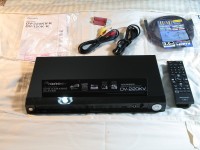
On the top left you have the manual that is all of 25 pages. That plastic cover also contains a warranty card. You then have the customary inexpensive batteries for the remote, composite cable and power cable. A new item is the 2 meter HDMI cable. Next to the player you have the remote.
THE PLAYER
I placed the player standing and tried a couple of snaps. Since I happen to be the worst (or best?) photographer in the world, I decided I to download the official photos for clarity.

The front of the player has the power button on the left followed by the disc tray, a button to open and close the tray, a small display panel, an USB slot, a 1.8mm microphone socket, volume control for the mike, and control for playing the disc. The microphone socket is used for Karaoke, a feature available with players sold in Asia. I show below a line drawing for greater clarity.

The rear has all the usual connections needed for using the player.

The only thing that I found different from previous models is that, for some reason, Pioneer had moved the power socket from the extreme right to the extreme left. For a little while I was blindly struggling to locate the socket till I turned the player around and found out the change.
In terms of connectivity, the player had an HDMI Out, a composite out, a component out (Pb, Pr, Py), and digital co-axial out. No DVI, SCART, S-Video nor an optical out. So, if you have a slightly old TV or AVR, you have to be careful.

THE DISPLAY
This is what I hate most about this player. Contrary to what we are all used to, the small LED display show letters in a horrible red colour. And, capitalization is really funny. Load is displayed as 'LOAd', USB as 'USb', Title as 'titLE', Stop as 'StOP', and GUI as '6UI'. More than a limitation of the LED display used, someone in Pioneer's design department must be rolling on the floor and laughing his guts out on how has made fool of a million people. The Manual also very happily says that this is how the words will be displayed. This is a major screw-up, though it does not hurt the usability of the player in any way. I hardly look at the player's display in any case excepting when I am opening and closing the disc tray. Rest of the time, I only look at the OSD screens.
REMOTE CONTROL
The DV-220 remote is, again, similar to all other Pioneer DVD Player remotes excepting for a few additions. Actually I tried using my DV-696 and DV-585 remotes on the DV-220 player and it worked perfectly for all functions excepting a few.
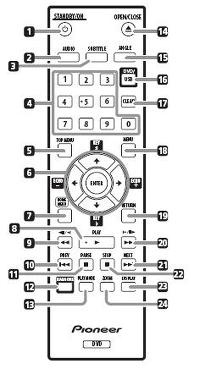
The additional buttons, or, shall we say new buttons, are USB/DVD (16) and Karaoke (12). When I compare it to the remote of DV-696 these have replaced two buttons that were there in the DV-696 - 'Enter' and 'Surround'. The Enter button was actually redundant as there is another Enter button in the centre of the remote. The Surround button enables Virtual Surround mode allowing you to 'hear' a simulated surround sound system from two speakers.
The USB button switches the player between playing a disc in the tray and using the USB port.
Contrary to older remotes in which the batteries are held side by side, the 220 remote holds the batteries along it full length one above the other. Standard AA batteries are used. The battery cover needs to be handled carefully as it looks flimsy enough to break easily.
PLAYER CAPABILITY
According to the manual, the DV220 can play the following formats:
ACCESSORIES SUPPLIED
Contrary to my expectations the HDMI cable that came along functioned quite well. It is 2 meters long, thick and is enclosed in a cotton sheathing like the ones used in cloth Irons. In the market this cable will sell for at least at least 750 to a 1000 Rupees.
The composite cable is, as usual, cheap. The power cord is ample, and I have never had any issue with Pioneer player's power cords. As long as you use a good extension cord or an adaptor in which the plug sits firmly, you will have no issues.
IN ACTION
I placed the DV220 on top of my Onkyo 875. I connected it to the AVR using the HDMI cable that came along with the player, albeit a little reluctantly. The reason for this reluctance is my bad experience with Panasonic cables that are sold in the market. The Pioneer HDMI cable came packed in a cellophane cover that had very similar colours and designs. Contrary to my expectation, the included HDMI cable came out a clear winner. Both connectors seem to be gold plated and had a plastic protecting cover in place.
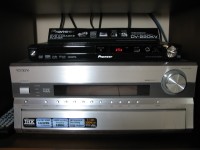
I powered up the units and started playing around with the DVDP settings. For a lark, I set the output to 1080P, and was amused by the picture dancing on the screen. My TV is only capable of 1080i, and was not able to take a 1080P signal. On the contrary, my Oppo 983 displays a steady picture, but with large number of artefacts on the screen. I groped with the 220 settings blindly for a few minutes to get it back to 720P and a steady picture.
I inserted a copy of The Hulk, and was thoroughly impressed with the picture quality. I would also like to add that I used the DV220 subsequently with a Denon 1910 and LG FullHD 42 inch TV. The images were equally impressive in that set up also. Though the 1910 is supposed to have a better upscaling engine, I could hardly make out a difference between the DV-220 and the 1910's FulHD outputs.
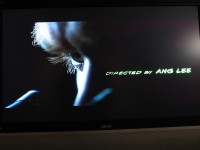
As you can see in the above picture, the eyelashes and eyebrow hair are very clearly visible. My photography is not very good, so the snap may be a bit out of focus.
As you can see in the following picture, colours are rendered exceedingly well for a DVDP at this price point.

In motion, the images were smooth and there were no jerks or pixelation. I will add an addendum to this review a bit later after seeing a few movies in full, but I have been using two Pioneers for a long time, and I don't foresee any major difference in the DV-220 also.
FEATURES, and CAPABILITIES
The DV-220 can, at best, be called an entry level player. But, for that it does have some nice capabilities. It has the following features:
1. Playing any DVD including DVD9 and all audio CDs.
2. Playing files stored on an USB device
3. Recording audio CD tracks onto an USB device
4. Playing audio is a desired order
5. Karaoke
I will discuss all these one by one excepting the Karaoke as I have never used it.
DVD/CD/VCD
The DV-220 plays all standard DVD including the DVD9. The player also understands and plays the video side of dual discs. It does not understand the audio side. The player plays the following formats:
as well as Pioneer's proprietary PureCinema 2:3 Progressive Scan. The player upscales to full 1080P through it's HDMI connector. The player supports all Versions of DivX Video, including DivX 6. The files have to be genuine DivX files.
The player supports standard Redbook CD, MP3, and WMA. Internally, the player has a 96 kHz/24-bit Audio DAC, but samples audio files to a maximum of 48kHz. If you want higher sampling rates, you have to take a digital out and process the audio externally. Dolby and DTS signals can be sent as PCM or RAW files for external processing.
For image files, the player supports .JPG or .JPEG files, and as mentioned above, proprietary Fujicolor and Kodak CDs.
THE USB Device
The player has a USB slot in the front. FAT16 and FAT32 file systems with a max of 300 folders are understood by the player. The player does supply power through the USB, but it is not enough to support some power hungry external drives. I used only an USB stick.
When you insert a USB stick and use the remote to switch between DVD and USB, the player displays the following screen.
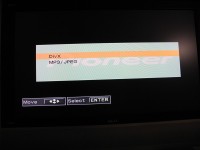
You can move the arrow keys on the remote to pick your choice and the click on Enter to make your choice. This is when the player did something very strange.
If you look at the directory structure of my USB stick as seen on my laptop, it is as follows:

But, when I inserted the USB stick on the player and chose DivX, it actually showed the following file structure:
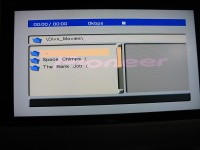
This was strange as the USB device did not have these files! Then I realized that I had used the USB stick some time ago to move these DivX movies from one computer to another and what the DV-220 does. It actually scans the whole USB drive and literally creates it's own structure of files it recognizes. It takes advantage of Microsoft's oversight of not physically removing files during Delete. For a lark, I scrolled to 'The Bank Job' and clicked on it. The DV-220 merrily played the movie for me. I did not sit through the whole movie, and I am assuming it will encounter an error somewhere in the movie where some of the file space have been taken up by other files as part of the Delete process.
I tried a couple of MP3 songs from Beatles' Rubber Soul, and decided not to do any detailed review. The sound was muddled and barely passable. I was not sure where the problem was till I tried the same on an Arcam Solo Mini where the same file played out much much better.
Coming to recording, the DV-220 records from an audio CD and creates MP3 files on the USB device. For this you have to insert an audio CD and an USB stick with enough space. Choose 'Home Menu' on the remote and then 'CD- > USB Rec' from the menu available. When you do this, you get the following screen.
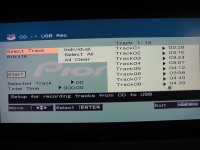
In track selection, you can choose between individual tracks or all tracks. In Bitrate, the player allows you to choose between 128kbps, 192kbps or 320kbps. I chose three tracks and 320kbps. Here is what I got.
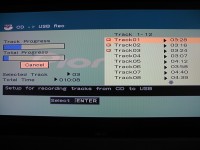
At 320kbps, each track takes some 30 to 40 seconds to encode. Again, at 320kbps, a 3.20 minute song takes roughly 38.4MB of space. The DV-220 creates a directory titled as 'PIONEER' and multiple sub directories within titled PIONEER01, PIONEER02 and so on for many recording runs as you enter. Within each sub-directory, the files are created simply with 'TRACKxx.MP3' as the names. The DV-220 uses MPEG 1 Layer III encoding and a sample rate of 44100Hz.
I had used Katie Meluah's Piece By Piece for this experiment. I took the USB stick across to an Arcam Solo Mini connected to Epos bookshelves. The files sounded quite nice, quite close to the original CD. If you are a little lazy, want to create a digital music library, and are agreeable to use MP3 files, using the DV-220 for this purpose seems a good option. EAC sometime takes 10 minutes for a 3 minute song and the Pioneer rips it in 30 seconds. But of course, the Pioneer will not have the accuracy that EAC has.
CONCLUSION
The DV-220 is a cute little player from Pioneer. It does what it says it will quite well. The video images are very good, and the USB performs well to help you view your photos as well as DivX movies. Movie sound decoded externally is clear and immersive.
There are limitations. It cannot be connected to an external hard disk, and cannot understand files such as MKV etc. But then it is not supposed do that nor double up as an audio player.
As a DVD player at a street price of roughly Rs.4,500, it delivers good value. Since I have been using Pioneer players for a long time and am used to it, I would be hard pressed to look elsewhere if I am looking for a DVD Player. I have not seen much change in the quality of the players from Pioneer over the last 5 odd years. They do become small and thinner, but that is the price of technical advancement.
Cheers
My first DVD was a Philips DVD718 that gave me nearly 10 years of good service. It was large and bulky, had the tray balanced bang in the centre, and had just a composite out. But, connected to a CRT, it played standard DVDs quite well. It had a bad habit of rejecting a number of DVDs as well as not understanding things like DiVX. After a lot of searching on the Net, I downloaded a firmware upgrade. After destroying some 6 odd CDs, it happily gulped the firmware, burped with an evil grin, and continued it's old behaviour of spitting out DVDs it did not like. But, for all it's idiosyncrasies, we lived happily together till the poor thing croaked about 3 odd years ago. I took the player to a Philips service centre who welcomed me and the player with large smiles written all over their faces. I was wondering why they were so happy, when they threw a Rs.15,000 and an unknown time estimate at me. Tucking my tail in and the DVD player firmly in my hands, I headed home. Given the fact that I was addicted to movies, what was I going to do next?
I had already started looking for an alternate DVD Player some five years ago, as I knew the Philips was nearing the end of it's life. My bible for DVDs, at least those days, was the DVD Benchmark of Secrets of Home Theater and Hi Fidelity (http://www.hometheaterhifi.com/cgi-...ype=&manufacturer=0&maxprice=0&deInt=0&mpeg=0) . Those days, Panasonic was dominating the Benchmark, and many reviewers were speaking of Panasonic's S97 with hushed tones. Unfortunately, though I trudged through every shop in Sim Lim Square and as many shops as possible in KL, it was just not available in Asia. It seemed to be a model specially made for the US, and I had an aversion to 110 volts.
Back home in India I had a seen a number of Pioneer players being sold and used all over, particular in buses, video rental shops and other places. Though the Benchmark did review some Pioneer players, their reviews were mixed. Some models were hailed as the 'best budget player'. Some were downright kicked out as 'a player I cannot recommend'. I then started surfing around for other reviews and found other sites were consistently happy with Pioneer players. The 696, in particular, was praised as an excellent player for the money.
So, in one of my trips to Singapore, I walked into a shop in Sim Lim Square and picked up a Pioneer DV-585. Connected to a Sharp 29 inch CRT, the player has given me excellent service for the last 4 odd years. A very simple player, the DV-585 had all the features I was looking for - 5.1, Dolby, DTS decoding, co-ax and optical digital out, 6 channel 192 kHz/24-bit D/A Converter, and 108 MHz/12-bit Video Signal D/A Converter. For the roughly Rs.3,500 (100 odd dollars), that I paid for it, I was very happy with it's performance.
About two years ago, I purchased a 32 inch flat TV and was planning for a HT system. So, it was time for a serious upgrade to the DVD Player. The 585 was sent to a bedroom with the Sharp TV where it continues to be used quite effectively. I started looking at Panasonic players again, but could not find one. Last April, I travelled extensively across Europe and thought that was a great opportunity to get a good player. In Amsterdam, I was walking in a street that had a number of electronic shops, and presto, a Panasonic S97 was displayed in all it's glory. I just could not resist and walked into the shop. Though I was ready to pay the 150 odd Euros the shop keeper asked for, he kept saying 'no play', 'no work India' and vague things like that. I just could not understand what he meant. Maybe he was talking about region code or that it had non-English messages. Anyhow hoping to find the same player in another shop, I started walking across a few more shops when I saw a window full of Pioneer players. It was like water to a guy who had just trudged across 100 miles of desert. Literally licking my lips in anticipation, I walked in, paid some 80 odd Euros and picked up a DV-696 without even giving the shopkeeper time to open his mouth. In my hurry I overlooked a few things that would haunt me for the next few months. One; made in Belgium, the player did not have an English manual. This was not too much of an issue as I was able to download the English version. More important, the player refused to play any DVD I threw at it. It was locked for Region 2, and that was it. I took the player to a couple of Pioneer service centres and called the Pioneer distributor in Mumbai. One service centre said he could change it to Region 5, but that it will be locked to region 5. I wanted Region 0, so that was out. In any case this was quite surprising as my DV-585 also says Region code 2, but plays all DVDs happily.
I wrote to Pioneer support in Singapore and their reply was the same - they do not encourage changing region codes. Here I was with a player I wanted that turned out to be a dud. How many times can I watch the same old demo DVD that came with the player? I then found out the support centre for Pioneer in Europe and wrote to them with a scanned copy of my purchase invoice. After about two weeks, I get a single line reply from Pioneer UK just giving me a link to PioneerFAQ. The punch line of this site was interesting - 'We add what they should have, but didn't'. And, to my great joy, they had a complete chapter on DV-696. I downloaded their firmware, loaded it to my 696, and it started playing all DVDs happily.
I later on went to buy a Pioneer 610, but a friend of mine stole that away from me. I did not have the energy to replace that as I already had three players including my Oppo 983.
Last week I had the fortune to come across a new Pioneer model, and thought I will write my impression on the player. The player model is Pioneer DV-220AV-K.
FIRST IMPRESSIONS
When I lifted the carton, I go the distinct feeling it was empty. At just 1.3Kg, the player is unbelievably light. And, at 14.1 inches wide, 1.6 inches tall and 7.95 inches deep, this is one of the smallest DVD players I have ever come across. Inside the carton, the player was packed as usual - covered with a plastic sheet and held in place with four corner Styrofoam packing. As usual, the Styrofoam packing seemed very flimsy. I removed all the items and placed them on a light coloured bed sheet for the following snap.

On the top left you have the manual that is all of 25 pages. That plastic cover also contains a warranty card. You then have the customary inexpensive batteries for the remote, composite cable and power cable. A new item is the 2 meter HDMI cable. Next to the player you have the remote.
THE PLAYER
I placed the player standing and tried a couple of snaps. Since I happen to be the worst (or best?) photographer in the world, I decided I to download the official photos for clarity.

The front of the player has the power button on the left followed by the disc tray, a button to open and close the tray, a small display panel, an USB slot, a 1.8mm microphone socket, volume control for the mike, and control for playing the disc. The microphone socket is used for Karaoke, a feature available with players sold in Asia. I show below a line drawing for greater clarity.

The rear has all the usual connections needed for using the player.

The only thing that I found different from previous models is that, for some reason, Pioneer had moved the power socket from the extreme right to the extreme left. For a little while I was blindly struggling to locate the socket till I turned the player around and found out the change.
In terms of connectivity, the player had an HDMI Out, a composite out, a component out (Pb, Pr, Py), and digital co-axial out. No DVI, SCART, S-Video nor an optical out. So, if you have a slightly old TV or AVR, you have to be careful.

THE DISPLAY
This is what I hate most about this player. Contrary to what we are all used to, the small LED display show letters in a horrible red colour. And, capitalization is really funny. Load is displayed as 'LOAd', USB as 'USb', Title as 'titLE', Stop as 'StOP', and GUI as '6UI'. More than a limitation of the LED display used, someone in Pioneer's design department must be rolling on the floor and laughing his guts out on how has made fool of a million people. The Manual also very happily says that this is how the words will be displayed. This is a major screw-up, though it does not hurt the usability of the player in any way. I hardly look at the player's display in any case excepting when I am opening and closing the disc tray. Rest of the time, I only look at the OSD screens.
REMOTE CONTROL
The DV-220 remote is, again, similar to all other Pioneer DVD Player remotes excepting for a few additions. Actually I tried using my DV-696 and DV-585 remotes on the DV-220 player and it worked perfectly for all functions excepting a few.

The additional buttons, or, shall we say new buttons, are USB/DVD (16) and Karaoke (12). When I compare it to the remote of DV-696 these have replaced two buttons that were there in the DV-696 - 'Enter' and 'Surround'. The Enter button was actually redundant as there is another Enter button in the centre of the remote. The Surround button enables Virtual Surround mode allowing you to 'hear' a simulated surround sound system from two speakers.
The USB button switches the player between playing a disc in the tray and using the USB port.
Contrary to older remotes in which the batteries are held side by side, the 220 remote holds the batteries along it full length one above the other. Standard AA batteries are used. The battery cover needs to be handled carefully as it looks flimsy enough to break easily.
PLAYER CAPABILITY
According to the manual, the DV220 can play the following formats:
- Commercially available DVD Video discs, DVD-R/ -RW/ -R DL and DVD+R/ +RW/ +RDL discs recorded in the Video mode and finalized
- DVD-R/ -RW/ -R DL discs recorded in the VR mode
- Video CDs (including Super VCDs)
- Commercially available audio CDs
- CD-R/ -RW/ -ROM discs containing music recorded in the CD-DA format
- JPEG files recorded on DVD-R/ -RW/ -R DL discs, CD-R/ -RW/ -ROM discs or USB devices
- DivX video files recorded on DVD-R/ -RW/-R DL discs, CD-R/ -RW/ -ROM discs or USB devices
- WMA files recorded on DVD-R/ -RW/ -R DLdiscs, CD-R/ -RW/ -ROM discs or USB devices
- MP3 files recorded on DVD-R/ -RW/ -R DL discs, CD-R/ -RW/ -ROM discs or USB devices
- Fujicolor CD
- KODAK Picture CD
ACCESSORIES SUPPLIED
Contrary to my expectations the HDMI cable that came along functioned quite well. It is 2 meters long, thick and is enclosed in a cotton sheathing like the ones used in cloth Irons. In the market this cable will sell for at least at least 750 to a 1000 Rupees.
The composite cable is, as usual, cheap. The power cord is ample, and I have never had any issue with Pioneer player's power cords. As long as you use a good extension cord or an adaptor in which the plug sits firmly, you will have no issues.
IN ACTION
I placed the DV220 on top of my Onkyo 875. I connected it to the AVR using the HDMI cable that came along with the player, albeit a little reluctantly. The reason for this reluctance is my bad experience with Panasonic cables that are sold in the market. The Pioneer HDMI cable came packed in a cellophane cover that had very similar colours and designs. Contrary to my expectation, the included HDMI cable came out a clear winner. Both connectors seem to be gold plated and had a plastic protecting cover in place.

I powered up the units and started playing around with the DVDP settings. For a lark, I set the output to 1080P, and was amused by the picture dancing on the screen. My TV is only capable of 1080i, and was not able to take a 1080P signal. On the contrary, my Oppo 983 displays a steady picture, but with large number of artefacts on the screen. I groped with the 220 settings blindly for a few minutes to get it back to 720P and a steady picture.
I inserted a copy of The Hulk, and was thoroughly impressed with the picture quality. I would also like to add that I used the DV220 subsequently with a Denon 1910 and LG FullHD 42 inch TV. The images were equally impressive in that set up also. Though the 1910 is supposed to have a better upscaling engine, I could hardly make out a difference between the DV-220 and the 1910's FulHD outputs.

As you can see in the above picture, the eyelashes and eyebrow hair are very clearly visible. My photography is not very good, so the snap may be a bit out of focus.
As you can see in the following picture, colours are rendered exceedingly well for a DVDP at this price point.

In motion, the images were smooth and there were no jerks or pixelation. I will add an addendum to this review a bit later after seeing a few movies in full, but I have been using two Pioneers for a long time, and I don't foresee any major difference in the DV-220 also.
FEATURES, and CAPABILITIES
The DV-220 can, at best, be called an entry level player. But, for that it does have some nice capabilities. It has the following features:
1. Playing any DVD including DVD9 and all audio CDs.
2. Playing files stored on an USB device
3. Recording audio CD tracks onto an USB device
4. Playing audio is a desired order
5. Karaoke
I will discuss all these one by one excepting the Karaoke as I have never used it.
DVD/CD/VCD
The DV-220 plays all standard DVD including the DVD9. The player also understands and plays the video side of dual discs. It does not understand the audio side. The player plays the following formats:
- DVD-Video discs
- Recordable DVDs such as DVD-R/ -RW/ -R DL and DVD+R/ +RW/ +RDL discs recorded in the Video mode and finalized
- DVD-R/ -RW/ -R DL discs recorded in the VR mode
- Video CDs (including Super VCDs)
- Audio CDs excluding SACD
- Recordable audio CDs such as CD-R/ -RW/ -ROM discs containing music recorded in the CD-DA format
- JPEG files recorded on DVD-R/ -RW/ -R DL discs, CD-R/ -RW/ -ROM discs
- DivX video files recorded on DVD-R/ -RW/-R DL discs, CD-R/ -RW/ -ROM discs
- WMA files recorded on DVD-R/ -RW/ -R DL discs, CD-R/ -RW/ -ROM discs
- MP3 files recorded on DVD-R/ -RW/ -R DL discs, CD-R/ -RW/ -ROM discs
- Fujicolor CD, KODAK Picture CD
as well as Pioneer's proprietary PureCinema 2:3 Progressive Scan. The player upscales to full 1080P through it's HDMI connector. The player supports all Versions of DivX Video, including DivX 6. The files have to be genuine DivX files.
The player supports standard Redbook CD, MP3, and WMA. Internally, the player has a 96 kHz/24-bit Audio DAC, but samples audio files to a maximum of 48kHz. If you want higher sampling rates, you have to take a digital out and process the audio externally. Dolby and DTS signals can be sent as PCM or RAW files for external processing.
For image files, the player supports .JPG or .JPEG files, and as mentioned above, proprietary Fujicolor and Kodak CDs.
THE USB Device
The player has a USB slot in the front. FAT16 and FAT32 file systems with a max of 300 folders are understood by the player. The player does supply power through the USB, but it is not enough to support some power hungry external drives. I used only an USB stick.
When you insert a USB stick and use the remote to switch between DVD and USB, the player displays the following screen.

You can move the arrow keys on the remote to pick your choice and the click on Enter to make your choice. This is when the player did something very strange.
If you look at the directory structure of my USB stick as seen on my laptop, it is as follows:

But, when I inserted the USB stick on the player and chose DivX, it actually showed the following file structure:

This was strange as the USB device did not have these files! Then I realized that I had used the USB stick some time ago to move these DivX movies from one computer to another and what the DV-220 does. It actually scans the whole USB drive and literally creates it's own structure of files it recognizes. It takes advantage of Microsoft's oversight of not physically removing files during Delete. For a lark, I scrolled to 'The Bank Job' and clicked on it. The DV-220 merrily played the movie for me. I did not sit through the whole movie, and I am assuming it will encounter an error somewhere in the movie where some of the file space have been taken up by other files as part of the Delete process.
I tried a couple of MP3 songs from Beatles' Rubber Soul, and decided not to do any detailed review. The sound was muddled and barely passable. I was not sure where the problem was till I tried the same on an Arcam Solo Mini where the same file played out much much better.
Coming to recording, the DV-220 records from an audio CD and creates MP3 files on the USB device. For this you have to insert an audio CD and an USB stick with enough space. Choose 'Home Menu' on the remote and then 'CD- > USB Rec' from the menu available. When you do this, you get the following screen.

In track selection, you can choose between individual tracks or all tracks. In Bitrate, the player allows you to choose between 128kbps, 192kbps or 320kbps. I chose three tracks and 320kbps. Here is what I got.

At 320kbps, each track takes some 30 to 40 seconds to encode. Again, at 320kbps, a 3.20 minute song takes roughly 38.4MB of space. The DV-220 creates a directory titled as 'PIONEER' and multiple sub directories within titled PIONEER01, PIONEER02 and so on for many recording runs as you enter. Within each sub-directory, the files are created simply with 'TRACKxx.MP3' as the names. The DV-220 uses MPEG 1 Layer III encoding and a sample rate of 44100Hz.
I had used Katie Meluah's Piece By Piece for this experiment. I took the USB stick across to an Arcam Solo Mini connected to Epos bookshelves. The files sounded quite nice, quite close to the original CD. If you are a little lazy, want to create a digital music library, and are agreeable to use MP3 files, using the DV-220 for this purpose seems a good option. EAC sometime takes 10 minutes for a 3 minute song and the Pioneer rips it in 30 seconds. But of course, the Pioneer will not have the accuracy that EAC has.
CONCLUSION
The DV-220 is a cute little player from Pioneer. It does what it says it will quite well. The video images are very good, and the USB performs well to help you view your photos as well as DivX movies. Movie sound decoded externally is clear and immersive.
There are limitations. It cannot be connected to an external hard disk, and cannot understand files such as MKV etc. But then it is not supposed do that nor double up as an audio player.
As a DVD player at a street price of roughly Rs.4,500, it delivers good value. Since I have been using Pioneer players for a long time and am used to it, I would be hard pressed to look elsewhere if I am looking for a DVD Player. I have not seen much change in the quality of the players from Pioneer over the last 5 odd years. They do become small and thinner, but that is the price of technical advancement.
Cheers
Last edited:

